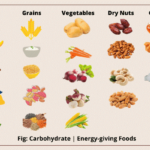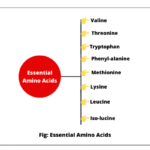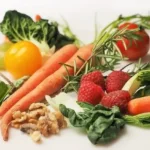Carbohydrates: Types, Functions, Sources, Example
A carbohydrate is a biomolecule ( or an organic compound) that consists of three elements: carbon(C), hydrogen(H), and oxygen(O) atoms. We also known it as saccharides. The saccharide means sugar.
Sugar is the simplest unit of carbohydrate whose chemical formula C6H12O6. The taste of sugar is sweet and generally found fruit, milk, honey, etc.
The general formula of carbohydrate is Cx(H2O)y where (x may be different from y). It contributes about 45% of calories in most of the diets.
Carbohydrate is an important and essential element that provides energy to our body. It is the main source of energy for our working muscles. We store carbohydrates in our muscles. When we exercise or play anything, our muscles use that stored carbohydrates to do work.
They are found in plant foods such as fruits, vegetables, grains, beans, and peas. Milk also contains significant amounts of carbohydrates that are derived from animals. Glucose is the simplest carbohydrates that give an instant source of energy. One gram of glucose will give you almost 4.2 kilocalories of energy.
Table of Contents
Types / Classification of Carbohydrates
Carbohydrates are classified on the basis of sugar or saccharide molecules. They are divided into two categories on the basis of their chemical structure. They are:
- Simple Carbohydrate
- Complex Carbohydrate

Simple Carbohydrate
Simple carbohydrate consists of one or two single-sugar (saccharide) units or molecules. They provide an instant source of energy. Simple carbohydrate is divided into two categories. They are:
- Monosaccharides
- Disaccharides
Monosaccharides:
Mono means single and sacchar means sugar or simple sugar. Monosaccharides are the simplest carbohydrates which are composed of only one sugar unit (one molecule of sugar).
Monosaccharides cannot be further broken down into simpler sugar. Therefore, it is called simple sugar and is the simplest form of carbohydrates. The richest natural sources of simple carbohydrates are fruits. There is no need to digest monosaccharides in the body.
Functions of Monosaccharides:
- Monosaccharides provide an instant source of energy. Human body consumes carbohydrates only in the form of monosaccharides.
- They are non-essential nutrients that you do not get them from the food. Your body can produce all the types of monosaccharides from other nutrients for proper functioning.
Examples of foods that contain free Monosaccharides:
- Fruits and fruit juices (glucose, fructose)
- Honey (glucose, fructose)
- Candies (glucose)
- Syrups: liquid glucose, corn syrup.
- Sweet wines: Soft drinks, energy drinks, chocolates, etc.
Types of Monosaccharides
Monosaccharides are further categorized into three forms, such as glucose, fructose, and galactose.
- Glucose
- Fructose
- Galactose
1. Glucose:
Glucose is also called dextrose. The molecular formula of glucose is C6H12O6. It provides an instant source of energy for all the body’s activities. The primary function of glucose is to provide fuel for all the cells. All the cells in the body use glucose to produce energy.
All types of carbohydrates are converted into glucose after digestion and blood absorbs carbohydrates in the form of glucose. This is the reason glucose is given to patients to provide instant energy.
2. Fructose:
Fructose is the sweetest among naturally occurring sugar which is mainly found in the ripe fruits and honey. That’s why it is also called fruit sugar that we get fruits.
The molecular formula of fructose is C6H12O6 same as that of glucose. It is not essential nutrients which you do not need to get it from the food to be healthy. All the fructose produces in your body from glucose.
The limited amounts of fructose can be used directly for energy. Most of the fructose reaches the liver via the vein and is converted into glucose, lipid, or lactate. Fructose also participates in the metabolism.
Fructose is present in Pear juice, Apple juice, Mango, Honey, Watermelon, Grapes, Orange juice, Tomato, etc.
3. Galactose:
It is also simple sugar which is composed of the same element as glucose but has the only difference in the arrangement of atoms.
Galactose is also not an essential nutrient. It also produces in the human body from glucose. Galactose is mainly present in fruits, vegetables, nuts, grains, meat, eggs, and milk.
Disaccharides
Disaccharides are carbohydrates that consist of two monosaccharide molecules or units joins together with the removal of a water molecule. The general formula of disaccharides is C12H22O11.
Examples of the disaccharides are sucrose, lactose, and maltose. It also provides energy to the body but is not essential nutrients for getting from the food to be healthy.
1. Sucrose:
Sucrose is disaccharide carbohydrates which consist of glucose, and fructose. It is a source of energy that is present in the Mango chutney, fruits, Ice cream, Coconut cream, etc.
2. Lactose:
Lactose is also called milk sugar and is composed of glucose and galactose linked by beta 1-4 glycosidic bond. The source of high lactose is milk, curd, yogurt, ice cream, etc. Lactose is a source of energy.
3. Maltose:
Maltose is a malt sugar which is composed of two glucose molecules connected with an alpha 1-4 glycosidic bond. The source of maltose is Honey, Jelly candies, Grapes, Pizza, meat, vegetables, etc. It also provides a source of energy.
Complex Carbohydrates
Complex carbohydrates are composed of long chains of sugar molecules. They are mainly found in foods such as peas, kidney beans, whole grains, Apples, bananas, and vegetables.
Both simple and complex carbohydrates are converted into glucose in the body. The complex carbohydrates foods give vitamins, minerals, and fibers which are essential for good health. An example of complex carbohydrates is Polysaccharides.
Polysaccharides
Poly means many and sacchar means sugar. Polysaccharides are complex carbohydrates which consist of 10 to 1000 monosaccharides arranged in chains. They are generally insoluble in water and fade in the taste.
With the help of several enzymes of the digestion process, polysaccharides convert into simple glucose. The main example of polysaccharides is starch, glycogen, Cellulose and Hemicellulose, dextrin, pectin.
1. Starch:
It is the main source of nourishment for humans. Plants store carbohydrates in the form of starch. The amount of starch occurs in cereal grains, seeds, roots like potato, tapioca, yam, and plantain.
All starch is broken down into glucose in the digestive system. When we cook rice, starch absorbs water and swells and ruptures. The number of glucose molecules in starch can vary from 2000 to 15000.
There are two types of glucose chains in the starch. They are:
- Amylose
- Amylopectin
Amylose: It is a long chain glucose and is easily soluble in water. About 10 to 20 percent of amylose molecules are present in starch. One molecule of amylose contains 500 – 5000 glucose molecules.
Amylopectin: About 80-90 percent of amylopectin occurs in starch. One molecule of amylopectin contains 50,000-5,00,000 glucose molecules.
2. Glycogen:
Glycogen is considered as animal starch. Animals store carbohydrates in the form of glycogen in the body. It stores in the liver and muscles. About 350 gm of carbohydrate is stored in the form of glycogen in the body that provides energy in the body.
3. Cellulose:
It is insoluble, indigestible polysaccharides. It contains more than 3,000 glucose molecules but for not human utilization. Cattle can digest cellulose.
4. Dextrin:
The starch which is partially broken into fragments either by digestion or by acids is called dextrin. It is broken down into maltose.
5. Pectin:
It is a polysaccharide with no nutritional importance but it is used in preparing jam and jelly.
Functions of Carbohydrates
There are the following important functions of carbohydrates. They are as:
- To give energy: The primary function of carbohydrates is to provide energy for the proper functioning of the body. One gram of carbohydrate provides 4 calories of energy. Excessive carbohydrate than essential are stored as glycogen and when needed, they convert to glucose and give energy.
- Protein saving: If the amount of carbohydrates in the food is sufficient, the body gets the necessary energy from which the source of energy provided by protein is not consumed. Hence, it saves for doing its main work.
- Helps in easy elimination: Cellulose, hemicellulose accelerates bowel motions and gives weight to feces from which helps in excretion. It also does not cause constipation.
- Helps in utilization of fats: Being a lack of carbohydrates, fats provide us energy. Because of excessive use of fat, the amount of acid inside the blood increases and the body becomes diseased. Therefore, it is necessary to have a carbohydrate in order to use the right amount of body fat.
- To bring variety and taste: Carbohydrates make food tasty due to sweetness. Faded carbohydrates also increase a variety of taste in the food.
Sources of Carbohydrates
Vegetation is the main and important source of carbohydrates. Most carbohydrates occur in the grain, dal, and root vegetables. Look at the below picture.
- Sugar, jaggery, and pure honey are the main sources of carbohydrates.
- Carbohydrates occur in all types of grains, such as wheat, rice, millet (bajra), sorghum (jowar), all types of dals.
- Carbohydrates occur in potatoes, peas, soybean, rajma.
- Dried Nuts: Almonds, Cashew, Choura
- Fruits such as Banana, Apple, Grapes, Chiku, etc. are the major source of carbohydrates.

Effect of Deficiency of Carbohydrates
Generally, there is no lack of carbohydrates in our food because carbohydrates are found in most food. Still, if there is a lack of it, the following diseases can be:
- There is a loss of body weight.
- Excess use of protein for energy causes the body not to build up, which slows down physical growth.
- Excess of fat for energy causes a disease called ketosis.
- Lack of carbohydrates causes weakness in the body form which the person to experience fatigue and lethargy.
- The skin starts dry and loose.
- Disorders occur in the digestive system. Due to which constipation is complained.
Effect of Excess of Carbohydrates
There are the following adverse effects of taking excess carbohydrates. They are as:
- By consuming more carbohydrate foods, they get absorbed in the body as fat and cause obesity by accumulation in the form of fat in the body.
- Sweet foods such as chocolate, toffee, sweets, etc., have harmful effects on the teeth.
- Excessive intake of carbohydrates causes increase possibility of diseases such as heart and diabetes.
How much carbohydrate should we intake per day?
The primary role of carbohydrates is to provide energy to our body. The true amount of carbohydrate in our daily diet for all age groups should be 45 – 65% of calories.
That is, WHO recommends the minimum amount of carbohydrate at least 130 gm per day for adults and children based on the minimum amount of glucose consumed by the brain. The intake of carbohydrates for a pregnant woman should be 170 gm.
Key Points to Remember about Carbohydrates
- The ample amounts of carbohydrates are always found in plant foods.
- Glucose is also known as blood sugar or dextrose.
- Lactose is the principal carbohydrate of milk.
- Glycogen is stored mainly in the liver and muscles.
- The liver is the primary organ that converts fructose into glucose.
- We eat most of the carbohydrates from three food groups: fruit, milk, and starch.
- A normal person should get 60% to 60% of the total energy from carbohydrates.
Top 30 Carbohydrates MCQs to Test Your Knowledge in Carbohydrates
In this tutorial, you have known about what is carbohydrate and its types, sources, functions, effect of deficiency, daily intake per day, etc. Hope that you will have understood the basic points of carbs. If you like this article and helpful, please share it with your friends on social networking sites.
Thanks for reading!!!







